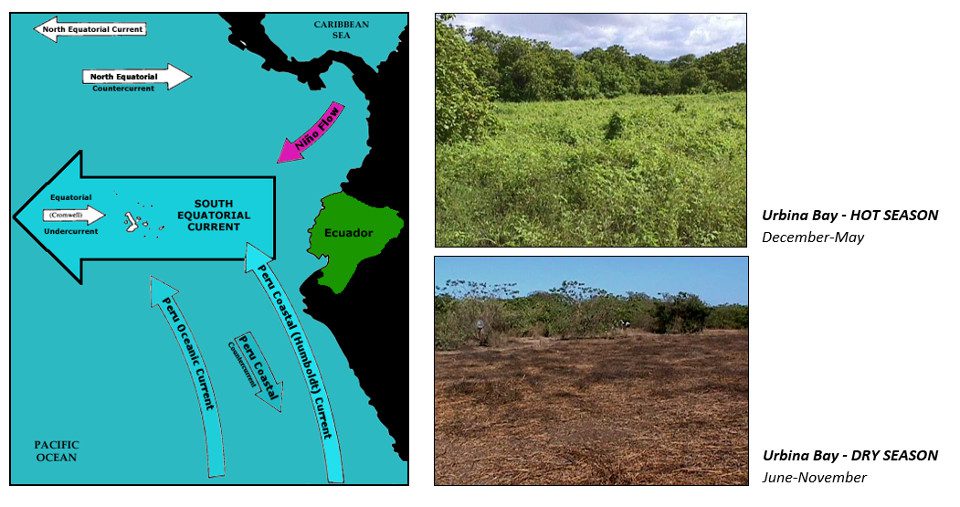Despite the fact that the Galapagos Archipelago is located directly on the equator, life in the islands is dictated by two very different climates: the wet season and the dry season. While the archipelago can be visited year-round, understanding Galapagos’ weather, the differences between these seasons, and their impact on the Galapagos ecosystems is important in planning the perfect Galapagos cruise vacation.
Understanding the Weather in the Galapagos Islands
The most important thing about understanding Galapagos weather is that there is no bad time to visit the archipelago. However, in general, Galapagos weather is dominated by a subtropical weather system due to the three major ocean currents that flow past the islands, decreasing temperatures, and rainfall. These marine currents also cause the weather to be quite variable in the islands, and so you will want to bring a range of outfits for your Galapagos vacation. Nevertheless, the weather is generally warm, similar to that of the Ecuadorian coastline.
For those who are particularly meteorologically inclined, understanding Galapagos weather can largely be interpreted by reading the wind currents present in the archipelago. Depending on the wind current, it is possible to understand which marine current is dominating the Galapagos at that time, and thus the climate.
June and November Currents
One of the main wind currents affecting the Galapagos Islands is the southeast trade winds. These winds start blowing in early May but are only truly felt in the Galapagos in June, with the arrival of the dry season, which dominates Galapagos weather for the next five to six months (peaking in September). The reason for this shift in weather is due to the arrival of the frigid Humboldt Current that the trade winds carry in. As waters cool, the air above is also cooled, affecting rainfall and temperatures (temperatures hover around the low 70’s). Certain areas in the islands still receive a steady source of moisture as they extend high enough to break the cloud cover, but rainfall in general decreases and is replaced by a fine mist, leaving the low-lying land significantly drier.
TALK TO A DESTINATION EXPERT

Diego Zapata

Rosa Mena

Sandy Lara

Diego Zapata

Rosa Mena

Sandy Lara
There are several benefits to this season that Galapagos travelers will want to keep in mind. To begin with, the season is particularly popular among professional divers as the cool waters are also extremely rich in nutrients and attract an astonishing assortment of marine life such as giant tortoises, humpback whales, swallow-tailed gulls, and penguins. The rich waters also provide more food for terrestrial life that depends on the ocean for food, such as sea birds and sea lions, providing an excellent time for breeding and reproduction. Mating rituals are commonly seen among several bird species, not to mention the adorable fluffy chicks that begin appearing in the islands.
December Showers Bring…May Flowers?
Come December, when the southeast trade winds all but die out and the cold waters are replaced by the warmer Panama Current, the surrounding air warms up, and more of a tropical feel appears in the islands. Temperatures can reach up to 85°F and the Galapagos Islands experience their warmest season up through late May. An average day is primarily sunny but may experience a short, sharp tropical storm similar to those that dictate Florida summers. At the height of the warm season (March), the islands begin to develop a lush, tropical look.
During this season, the waters that surround the islands are much warmer (with a comfortable maximum of 80°F) and clearer, with visibility reaching over 30 feet, benefitting those who enjoy more of a relaxing swim. This season is also marked by increased numbers of tropical fish, as well as the occasional manta ray.
Beauty of the Transition Months

Just as each season has its own particular highlights, the transition months also share their own beauty with visitors to the islands, packing in the best of both worlds. The months of May and June (from hot to dry), and December and January (from dry to hot) are known as transition months in the Galapagos and are dictated by relatively warm ocean temperatures accompanied by a gentle ocean breeze that cools the air; clear skies also make for excellent stargazing. These time of year to visit Galapagos is also particularly rewarding for spotting wildlife in the islands, particularly the migratory species.
Understanding Galapagos Weather and Deciding What to Pack
Weather in the Galapagos is generally warm, fluctuating anywhere between 69 and 85°F; however, it is highly recommended to dress in layers in the Galapagos. The sea breeze can be quite chilly at times, but when the sun is out the land can get very hot. Furthermore, the longer layers will hope to protect your skin from the ultraviolet sun rays that are particularly strong and potentially dangerous along the equator. We also recommend visitors to use a sunscreen of at least SPF30.
Additionally, items like an umbrella, insect repellent, and a raincoat are always a good idea in the Galapagos. You very well might not use them, but these islands are known for their variable weather patterns. Check our Galapagos packing list for any additional items you are not sure about.
Read more travel tips before your trip to Galapagos, how to know what works best for you.

Javier Garcia

Eduardo Silva

Carolina Escobar
START PLANNING YOUR TRIP

Javier Garcia

Eduardo Silva

Carolina Escobar
Get in touch for more
CONTACT US


